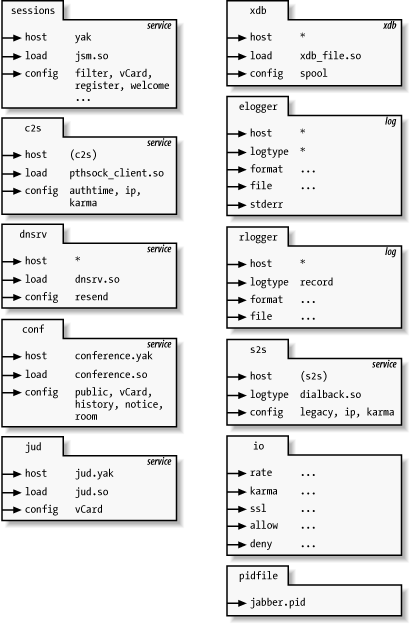A Tour of jabber.xml
Now that we know what patterns to look out for, we’re well prepared to dive into a jabber.xml configuration file. As an example, we’ll take one that’s very similar to the default jabber.xml installed with Version 1.4.1 of Jabber, but we’ll plug in some extra components: the conferencing component and a local JUD component.
The entire configuration content, with comment lines dividing up each section, can be found in Appendix A. It’s definitely worth turning briefly to have a look at the XML before continuing, to get a feel for how the configuration is laid out.
In order to deal with it without going crazy, let’s break down the
XML into manageable chunks.
We’ll build configuration diagrams for each of the top-level tags
that are children of the root tag
<jabber/>.
The opening tags for each of these chunks are as follows:
<service id="sessions"><xdb id="xdb"><service id="c2s"><log id="elogger"><log id="rlogger"><service id="dnsrv"><service id="jud"><service id="s2s"><service id="conf"><io><pidfile>
Most of these should be recognizable by now, but there are two chunks that
we haven’t come across yet:
<io> and
<pidfile>.
These aren’t components but nevertheless are part of the configuration
for jabberd; there are also the two
Logging component instances that we have not paid
much attention to until now.
Figure 4-4 provides an overview of how the Jabber server is configured. It represents the contents, in diagram form, of the jabber.xml configuration file in Appendix A.
We can see that the bulk of the Jabber server functionality described here is in the form of components. Let’s take each of these components—the chunks—one by one and have a closer look. The remainder of this chapter describes each of these chunks in detail.
Get Programming Jabber now with the O’Reilly learning platform.
O’Reilly members experience books, live events, courses curated by job role, and more from O’Reilly and nearly 200 top publishers.


